

WHY CHOOSE TO SUPPORT SUSTAINABLE TOURISM IN CAMBODIA
Sustainable tourism in Cambodia matters!
Traveling is one of our favourite activities, but sometimes it can have a harmful effect on the environment. It may also put pressure on the environment, especially when there’s a huge number of visitors in regions where the resources are already inadequate, like in Cambodia.
Unrestrained traditional tourism can be a possible threat to lots of natural resources in South East Asia, including:
- Forests regularly endure the destructive effect of tourism due to deforestation created by land clearing for hotels, as well as being used as building material and fuel for the tourism industry.
- Loss of natural habitat and wildlife due to loss of natural environment and forest that leads to degradation of local biodiversity. As many as 23 endangered or critically endangered species can be found in just one corner of Cambodia, in the wilderness that gently bumps up to Vietnam’s boarders.
- Water shortage – It is very evident that the tourism industry overuses the water resources for the development of golf courses, swimming pools, hotels, and even the personal use of water by some tourists.
- Tourism may positively impact Cambodia and the large cities in terms of economic advantages, employment opportunities, foreign exchange earnings, and growth in the service sector, however very little of these benefits trickle down to remote areas and rural communities.
For these and many other reasons, sustainable tourism in Cambodia matters. We think, as many others do, that the impact of our travels on the environment, local community and local eco-systems should be minimal.
We know that your time is precious, your vacation time is short and the year is long, and that you might have many options for your gap year.
There are far too many options for where to go, what to see and what activities you should choose to do. If you choose to travel sustainably in Cambodia, it does not mean missing out on the many awe-inspiring, once in a lifetime experience that this diverse, beautiful, fascinating and complex country has to offer. On the contrary, sustainable tourism is your passport into an authentic experience in Cambodia and this part of Southeast Asia.
With so many places to choose from and with such a wide range of experiences on offer, it can be extremely confusing and difficult to make the most sustainable and “green” choice for your trip. WE HEAR YOU! You want to choose carefully where we go, where we stay and how we use our money… ensuring that your money is used wisely and that your spending meets your values and principles.
We understand how damaging it is: to visit children’s orphanages, to go to animal petting wildlife sanctuaries or to pay for riding the elephants… therefore the only way to be and to travel to SUPPORT SUSTAINABLE TOURISM IN CAMBODIA.
If we can get more people, like you, to choose local community based tourism experiences and visits to ecotourism sites, sustainable tourism can become an effective tool for sustainable development in rural Cambodia. Here are just few examples of the power sustainable travel has:
- As a direct result of your visit, local communities will be able to achieve an increase in their families income, leading to a reduction in poverty and more educational opportunities for their children. This is possible due to the creation of alternative livelihood options through community-based tourism businesses and employment opportunities.
- It helps to safeguard natural resources and it helps to protect endangered species such as gibbons, elephants, Giant Ibises etc.
- Empowered local communities – especially for women and young people.

CHARITY IS NOT THE SOLUTION, SUSTAINABLE EMPLOYMENT AND EDUCATION ACHIEVED THROUGH SUSTAINABLE TOURISM IN CAMBODIA CAN BE THE SOLUTION!
For you, sustainable travel not only offers you the chance to see a side of Cambodia that few do, but it also enables travelers to have “real” experiences while meeting local people, experiencing the richness of local culture and exploring the natural biodiversity.
Year 2017 was appointed as the International Year of Sustainable Tourism for Development by the United Nations with the campaign slogan of Travel.Enjoy.Respect. Since the start of the year, the World Tourism Organization (UNWTO) – the United Nations Specialized Agency for Tourism has been working tirelessly to raise awareness of the extensive role sustainable tourism plays in development, and its immense socio-economic opportunities while encouraging all stakeholders to work together to build a better, more sustainable future through tourism.
SIGN UP & KEEP IN TOUCH
Recent posts.
- My Experience in homestays in Ratanakiri
- Indigenous Homestay in Ratanakiri
- Ecotourism Camping in Cambodia
- Trekking in Mondulkiri
- Sustainable choices Angkor Wat, Siem Reap
<h2></h2> <h2><span style=”color: #ffffff;”>Use our map to locate eco-tourism projects and community based tourism sites</span></h2> Planning your trip has never been easier, in order for you to have a better understanding where each project/site is and how best to plan your trip we have compiled an interactive map with a location of each ecotourism or community based tourism site. Enjoy your search! To start just close up this pop up.
Pin It on Pinterest
- 2 February 2023
The Royal Government of Cambodia has acknowledged the potential of the tourism industry as a source of Cambodia’s socio-economy growth, including job creation and poverty reduction. Tourism has been considered one of Cambodia’s key economic pillars, both international and domestic. In the early 2000s , the top foreign tourists to Cambodia were westerners from the United States, United Kingdom, and France. 1 Chinese tourists have topped the 2019 Cambodia arrival list accounting for 2.36 million visitors. 2 It shows an 18 percent increase from 2018. Chinese tourists remain at the top for 2020, followed by Thailand and Vietnam . 3 Other tourist arrivals are from the United States, the Republic of Korea, Japan, France, and Chinese Taipei. 4 For outbound departure, Cambodia has traveled the most to Thailand (42 percent), Vietnam (30 percent), Taiwan (12 percent), China (5 percent), Malaysia (4 percent), and the rest of the world (7 percent) in 2019. 5
In 20 19, there were approximately 11.3 million domestic and 6.61 million international tourists. 6 In 2022, Cambodia recorded 2.2 million international visitors, an 11 percent increase from the previous year. 7 International tourist revenue shared of Cambodia’s GDP was 9.44 percent in 2000 . 8 The number increased to 19.61 percent in 2019. 9 International tourist receipts are equivalent to 228 million USD in 2000 and 4,919 million USD in 2019. 10 However, the number dropped significantly in 2020 as the world was hit with COVID-19’s quarantine and travel restrictions. In 2020, international tourist receipts dropped threefold from the previous year to around 1,023 million USD. 11
Tourism directly employed 630,000 workers , of which 60 percent were women in 2019. 12 The sector is only second to the garment sector with the largest number of women employed. In terms of hotels and accommodation, a s of 2020 , a total of 1,028 hotels provide 44,428 rooms residing in 25 provinces across Cambodia. 13 Another accommodation type is the guesthouse, in which 2,755 units are divided into 35,791 rooms are available for tourists. 14 As the tourism industry grows and demand for accommodation spike over the year, the number of hotels and guesthouses also increase. In 1998, there were only 216 hotels and 147 guesthouses. It shows a growth rate of 386 percent and 1.740 percent for hotels and guesthouses, respectively. 15
Cambodia’s top tourist destination is the Angkor Archaeological Park in Siem Reap. The park covers 400 square kilometers and consists of forest areas and many ancient temples. It is home to Angkor Wat temple, the largest religious temple in the world. The temple was listed as UNESCO World Heritage in 1992. 16 Angkor Wat and other temples in the Angkor Archaeological Park have generated millions of dollars and attracted millions of local and international travelers each year. In 2019 , Angkor Wat attracted approximately 2.2 million international tourists generating 99 million USD in revenue through ticket sales. 17 Other tourist’s popular destinations are coastal areas (Preah Sihanouk, Koh Rong, Kep, Koh Kong, and Kampot), mountain areas (Battambang, Rattanakiri, Mondulkiri, Pursat), and ecotourism that spread out across the countries .
Ecotourism and Communities-Based Ecotourism (CBET) in Cambodia
The United Nations World Tourism Organization defines ecotourism as “all nature-based forms of tourism in which the main motivation of visitors is the observation and appreciation of nature as well as the traditional cultures prevailing in natural areas.” 18 While communities based ecotourism involves the local communities’ participation and natural resource management, who will gain direct benefits through ecotourism activities in their areas. 19 As communities-based ecotourism generate profit for the local, it also preserves the natural resources and environments. For a country with rich natural landscapes and attractions, Cambodia has the potential for ecotourism development. 20
In the last decades, ecotourism has experienced rapid growth. The main reason for the change is the government’s prioritization of diversifying the sector and the need for sustainable tourism. I n 2017 , the interministerial ecotourism task force was formed to manage and develop potential communities based tourism in Cambodia. 21 In addition, i n 2021 , based on the success of the interministerial task force, the National Committee for Management and Development of Community-Based Tourism and Ecotourism (NCDCBE) was established. 22
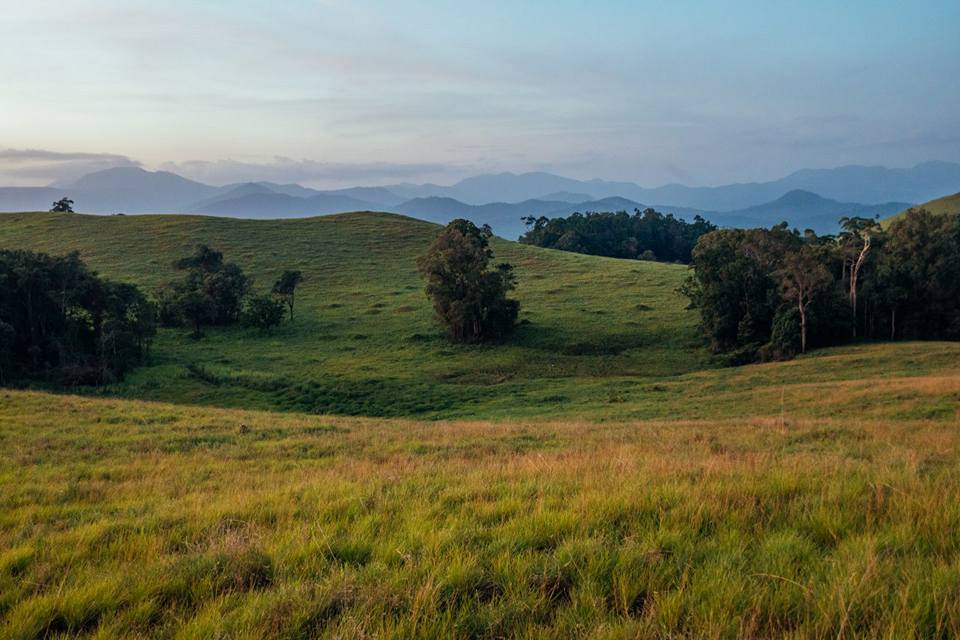
Virachey National Park, Ratanakiri, Cambodia. Photo taken from Ministry of Tourism’s Facebook page on 05 October 2017.
As of 2019, the Ministry of Tourism stated that there are around 266 ecotourism sites, 13 of which are community base ecotourism operating across Cambodia. 23 In 2019 , ecotourism shared 16 percent of the total tourist visit in Cambodia. 24 The number has accelerated during the COVID-19 pandemic as the demand for domestic tourism increased due to international travel restrictions. In 2022, The Ministry of Environment approved 307 small-scale ecotourism projects, which shows a hike in ecotourism demand in the past few years. 25 Also, the Ministry of Agriculture has identified 131 agricultural communitie s that have the potential to convert into communities-based ecotourism that can improve the local’s living standard. 26
In collaborating with the World Bank, the Ministry of Environment implemented the Sustainable Landscape and Ecotourism Project (CSLEP) in 2019. The 50.66 million USD project aims to promote ecotourism and non-timber forest products in the Cardonmon mountain and Tonel Sap landscape, which they identified as potential areas for communities-based ecotourism development; namely, the Koh Kong province, Siem Reap province, and Phnom Aural protected area. 27 Under the CLSEP project, various frameworks are published including the Process Framework of the Cambodia Sustainable Landscape and Ecotourism , Indigenous People Planning Framework of the Cambodia Sustainable Landscape and Ecotourism and Resettlement Policy Framework of the Cambodia Sustainable Landscape and Ecotourism.
Tourism in the context of the COVID-19 pandemic
Having tourism as one of their main source of revenue, Cambodia felt the impact of COVID-19 . At the beginning of the pandemic, the tourism sector was drastically affected. The reason is mainly due to the travel restriction that prevents foreign tourists from traveling. 28 Foreigners visiting Cambodia dropped significantly from 6.61 million in 2019 to 1.3 million visitors in 2020. 29 It is estimated that Cambodia has lost 3 billion USD of tourism revenue to the COVID-19 pandemic. 30
I n 2020 , Tourism-related employment decreased by 21.7 percent from the previous year. 31 It was equivalent to 2.33 million in employment in 2019 to 1.82 million in 2020. 32 As of September 2020 , the Ministry of Tourism reported that about 3000 tourism-related businesses were closed or suspended. 33 About 62 percent o f the affected business were based in Siem reap, forcing nearly 15,000 workers out of jobs. 34 Most suspended or laid-off workers turn to the agricultural sector to support their daily incomes.
The government has initiated various long and short-term recovery responses to retrieve the tourism industry. Those measures include tax/fee exemptions and cash support/loans for tourism-related businesses and enterprises, vaccination campaigns and capacity development for employees in the tourism sector, and infrastructure development. For instance, on February 2020 , a policy on monthly tax exemption for all hotels and guesthouses in Siem Reap was issued. This tax exemption policy for tourism-related accommodation has been extended until March 2023 . In addition, on May 2022, the government launched 150 million USD of the Tourism Recovery Co-financing Scheme (TRCS), which comes from the RGC’s contribution of 75 million USD through the Small and Medium Enterprise Bank of Cambodia (SME Bank) and Participating Financial Institutions (PFIs) contribution of 75 million USD. The enterprises in the tourism sector affected by the COVID-19 crisis can apply for loans from participating financial institutions that are partners of SME Bank at a concessional interest rate.
The government has implemented the Roadmap for Recovery of Cambodia tourism during and post COVID-19 . The roadmap is a comprehensive guideline that aims to strengthen the tourism sector during the post-COVID-19, mitigate the negative impact of the pandemic, and promote Cambodia’s prestige and tourism as a safe destination for post-pandemic. The roadmap consists of three phases of recovery such as:
- Phase 1: Crisis management in the new normal phase and planning for recovery (2020-2021)
- Phase 2: Recovery of the tourism sector in Cambodia in the post-COVID (2022-2023)
- Phase 3: Preparation for the new future of the tourism sector in Cambodia (2024-2025).
Challenge and way forward
Despite gaining a large number of international tourists each year, Cambodia’s tourism sector still has room for improvement and to capitalize on the potential. The kingdom heavily depends on Angkor Wat as the main tourist attraction has made the country’s tourism sector vulnerable to external shock. For instance, the COVID-19 pandemic has presented a reality test for Cambodia’s tourism sector. The travel restrictions and border closure negatively affect all tourism-related businesses, especially in tourism-driven provinces such as Siem Reap and Preah Sihanouk.
A limited selection of destinations is also a problem. Cambodia needs to diversify the tourism sector in order to keep the average length of tourists’ stay high. In 2018, the average length of stay of international tourists was seven days, one day shorter than in 1995. 35 The longer stay usually means more spending, thus generating more revenue for the sector. Diversifying the tourism sector to more than just temple tours will attract tourists to stay longer as it offers more options for tourists to explore. The government has recognized ecotourism as a solution to diversify the tourism industry. In addition, the Strategic framework and programs for economic recovery and to promote Cambodia’s economic growth in living with COVID-19 in the new normal for 2021-2023 has identify areas for tourism diversification such as the coastal areas, northeastern regions, and natural landscapes such as Tonle sap, Mekong, and Bassac river.
Another issue associated with Cambodia’s tourism is poor infrastructure and limited transportation . 36 Infrastructure and transportation in other areas besides popular international destinations are often poor quality and underdeveloped. Roads, network connectivity, electricity, clean water, and sanitation in remote tourist sites can be unsatisfactory. 37 The establishment of the Master Plan for Siem Reap Tourism Development 2021-2035 , Master Plan for Mondulkiri Tourism Development 2021-2035 , the Phnom Penh-Sihanouk expressway, the new Siem Reap international airport are the government’s attempts to enhance and diversify the sector through infrastructure and connectivity development.
For 2023, Cambodia’s government has projected to receive four million international tourists, providing a positive aspect for a post-COVID-19 recovery in the tourism sector. 38 This could generate 4 billion USD in revenue for the country. 39
Related to Tourism
- Economy and commerce
- 1 . Peter Varga, “ Angkor Wat: The Impact of Mass Tourism, ” EHL insight, accessed January 2023.
- 2 . Khmer Times Staff, “ Chinese top tourist arrivals in 2019, ” Khmer Times, February 2020, accessed January 2023.
- 3 . Ministry of Tourism, “ Tourism Statistic Report December 2020 ,” December 2020, accessed January 2023.
- 5 . World Travel Tourism Council, “ 2022 Annual Research: key highlights, ” 2022, accessed January 2023.
- 6 . Economic Diplomacy Coordinating Group, “ Dashboard series about Cambodia ,” Ministry of Foreign Affair and International Cooperation, November 2021, accessed January 2023.
- 7 . Hin Pisei, “ International visitors top 2.2M in 2022, lifting 2023 hopes, ” The Phnom Penh Post, January 2023, accessed January 2023.
- 8 . Global Economy, “ Compare countries with annual data from official sources ,” accessed January 2023.
- 10 . Ministry of Tourism, “ Tourism Statistic Report February 2022 ,” February 2022, accessed January 2023.
- 12 . Asian Development Bank, “ Sector Assessment Summary: Tourism in Cambodia ,” Community-Based Tourism COVID-19 Recovery Project, January 2022, accessed January 2023.
- 13 . Economic Diplomacy Coordinating Group, “ Dashboard series about Cambodia ,” Ministry of Foreign Affair and International Cooperation, November 2021, accessed January 2023.
- 16 . UNESCO, “ UNESCO statement on a reported construction project near the World Heritage site of Angkor in Cambodia ,” February 2021, accessed January 2023.
- 17 . Khmer Times Staff, “ Cambodia’s famed Angkor sees more than 45,000 international tourists in first 5 months ,” Khmer Times, June 2022, accessed January 2023.
- 18 . United Nations World Tourism Organization, “ Ecotourism and protect areas, ” accessed January 2023.
- 19 . Phe Siphannara, “ Overview of community-based ecotourism for sustainable development in Cambodia ,” September 2019, accessed January 2023.
- 20 . OECD, “ Structural policy country note: Cambodia ,” Economic outlook for Southeast Asia, China India 2019: Towards smart urban transportation, December 2019, accessed January 2023.
- 21 . Post Staff, “ Hun Sen gives nod to creation of ecotourism task force ,” November 2017, accessed January 2023.
- 22 . Tin Sokhavuth, “ Gov’t orders formation of NCDCBE to boost tourism sector ,” October 2021, accessed January 2023.
- 23 . Phe Siphannara, “ Overview of community-based ecotourism for sustainable development in Cambodia ,” September 2019, accessed January 2023.
- 24 . Rawlins, et al, “ Enabling ecotourism development in Cambodia, ” World Bank, 2020, accessed January 2023.
- 25 . Sok Sithika, “ 307 small nature tourism projects approved in September, ” Khmer Times, October 2022, accessed January 2023.
- 26 . Khmer Times Staff, “Ministry identifies 131 potential ecotourism communities, ” Khmer Times, July 2022, accessed January 2023.
- 27 . Ministry of Environment, “ Cambodia Sustainable Landscape and Ecotourism Project, ” February 2020, accessed January 2023.
- 28 . Ngin Chanrith, “ COVID-19 and the Tourism sector in Cambodia: impact, response and the road to recovery, ” 2022, accessed January 2023.
- 30 . Ministry of Tourism, “ Roadmap for Recovery of Cambodia tourism during and post COVID-19,” 2021, accessed January 2023.
- 31 . World Travel Tourism Council, “ 2022 Annual Research: key highlights, ” 2022, accessed January 2023.
- 33 . Khmer Times Staff, “ 51,000 tourism-based jobs in Cambodia vapourised because of COVID-19 pandemic ,” Khmer Times, November 2020, accessed January 2023.
- 35 . Perter Varga, “ Angkor Wat: The Impact of Mass Tourism, ” EHL insight, accessed January 2023.
- 36 . George Styllis, “ Tourism slowdown threatens Cambodian model ,” July 2016, accessed January 2023.
- 38 . Khmer Times Staff, “ Four million international tourists expected by Cambodia this year after China’s pandemic strategy optimization ,” Khmer Times, January 2023, accessed January 2023.
- 39 . Chea Vanyuth, “ Cambodia expects tourism generating $4B in 2023 ,” Khmer Times, January 2023, accessed January 2023.

- Ask Question
- Report Problem
- Send Feedback
- Submit Resources
Do you have questions on the content published by Open Development Cambodia (ODC)? We will gladly help you.
Have you found a technical problem or issue on the Open Development Cambodia (ODC) website?
Do you have a new idea that could help transform the Open Development Cambodia (ODC) website? We will be glad to hear it.
Tell us how we're doing.
Do you have resources that could help expand the Open Development Cambodia (ODC) website? We will review any map data, laws, articles, and documents that we do not yet have and see if we can implement them into our site. Please make sure the resources are in the public domain or fall under a Creative Commons license.
Disclaimer: Open Development Cambodia (ODC) will thoroughly review all submitted resources for integrity and relevancy before the resources are hosted. All hosted resources will be in the public domain, or licensed under Creative Commons. We thank you for your support.
Thank you for taking the time to get in contact!
Lorem ipsum dolor sit amet, consectetur adipiscing elit. Etiam posuere varius magna, ut accumsan quam pretium vel. Duis ornare

Cambodia’s rich, iconic and natural diversity provides countless opportunities for exciting, safe and green adventures that will take you ‘Beyond the Temples’. From the remote green forests of the Northeast Region and the Cardamom Mountains to the marine habitats of the coast and islands there is so much to explore.
The passionate and committed communities, tour guides and conservation organisations highlighted on this site will help you to discover the wonders of Cambodia, and leave with enriched knowledge and understanding of the importance of protecting these Green Treasures for future generations.

What is Ecotourism?
E cotourism is “responsible travel to natural areas that conserves the environment, sustains the well-being of the local people, and involves interpretation and education” (TIES, 2015). As an ecotourist in Cambodia, you can explore and experience nature in a sustainable manner, respect our cultural heritage and most importantly, build environmental awareness.
Ecotourism activities not only bring together nature conservation efforts, the local people and sustainable traveling – it can make a lasting positive impact on the local communities and environmental ecosystems. Being a real ecotourist is much more than having a holiday in nature, it is becoming part of the nature, while caring, supporting, and understanding it. Enjoy becoming part of EcoCambodia .
Trending Destinations

Kampong Thom Province
Central region.

Kampot and Kep Province
Coastal region.

Kratie Province
Northeastern region.

Preah Vihear Province
Siem reap region.

Ratanakiri Province
Responsible ecotourist tips.

Be mindful of conservation
Support preserving our natural and cultural heritage in all you do.

Communicate with the locals
Learn more about the local nature and culture and contribute to livelihood change by raising awareness for eco-tourism destinations.

Support local businesses
Help provide sustainable financing to the local community by patronising local restaurants and souvenir shops.

Keep nature clean and intact
Take nothing but photographs, leave nothing but footprints. Do not collect natural souvenirs, do not leave waste and help clean up any waste found in nature.

Respect our wildlife
Do not take part in any activities that exploit or cause harm to wild animals in any way.

Use ethical tour operators
Support local responsible operators that contribute to both nature conservation and environmental research.

Explore non-popular areas
Avoid ‘over-tourism’, and support these communities’ tourism development by sharing the region’s features digitally on social media.

Actively reduce, reuse, recycle
Minimise your environmental footprint.

Be ethical and sustainable
Raise environmental awareness and educate others.
Support preserving our natural and cultural heritage in all you do
Take nothing but photographs, leave nothing but footprints, do not collect natural souvenirs, do not leave waste and help clean up any waste found in nature
Support local responsible operators that contribute to both nature conservation and environmental research
Avoid ‘over-tourism’ and support these communities’ tourism development by sharing the region’s features digitally on social media

Enabling ecotourism development in Cambodia
Maurice andres rawlins, elisabeth steinmayr, werner kornexl.
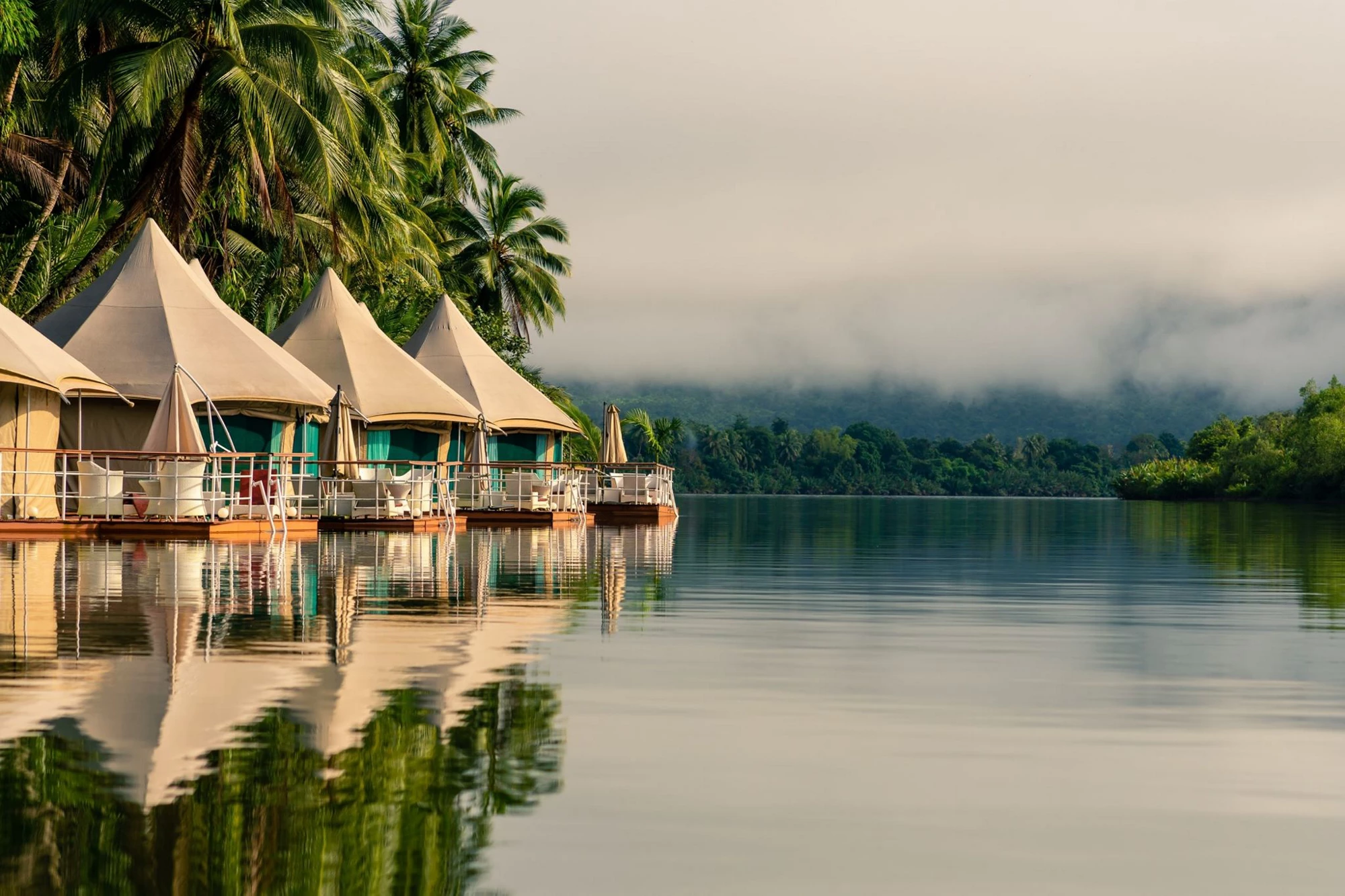
Iconic Cambodian landscapes, such as the Cardamom Mountains have a wealth of natural assets that allow for new and exciting multi-day tourism itineraries for domestic and international markets. In addition, the remoteness of Cambodia’s picturesque forested landscapes also entices the mid to high-end tourist market, who are looking to unwind and unplug.
Cambodia’s tourism industry is a key contributor to its economic growth. It provides a sizable contribution to Cambodia’s economy (21 percent of GDP in 2019) , which has been on the rise for the past ten years. The ecotourism sector was a notable part of this and, in recent years, was showing signs of even greater growth than the rest of the tourism industry.
A recent slowdown in the growth of tourism in Cambodia , however, points to a need to diversify the sector. Angkor Wat in Siem Reap has been the main attraction to Cambodia, and while the iconic temples still draw crowds, statistics show that growth in arrivals to Angkor sites is slowing. Experts suggest that the decelerated growth of tourist arrivals is due to fewer Chinese tourists visiting Siem Reap. Instead, these tourists are increasingly drawn to Cambodia’s coastal areas. Another reason is that higher competition from neighboring countries, especially Vietnam, is drawing Chinese and South Korean tourists away from Siem Reap.
Trends of increased visitors to ecotourism sites in Cambodia indicate that ecotourism is a product that could be further developed to harness its potential, and the Cambodian government wants to capitalize on this potential. Developing tourism can also create much-needed revenues to help manage Cambodia’s extensive protected area (PA) network and protect important economic services provided by forests in the PAs.
“Invest now in ecotourism development to: DIVERSIFY Cambodia’s tourism product with ecotourism offerings; CREATE jobs and STIMULATE rural economies; and PROTECT the forest assets that underpin ecotourism” is one of the main key messages that has been formulated in a newly released World Bank advisory report on Enabling Ecotourism Development in Cambodia ; a report which has been developed to support the Royal Government of Cambodia in the sustainable development of ecotourism. One of the main tenets promoted in the report is around investing and diversifying the country’s tourism, which is part of the Bank’s broader strategy for sustainable management of the country’s natural capital and strengthening its links to the economy.
COVID-19 is an additional reason for diversifying the country’s tourism offerings. “BUILD BACK BETTER after COVID-19 in the tourism sector by investing in ECOTOURISM” is another key message being promoted in the World Bank’s advisory report. As more people become unemployed due to the fallout of COVID-19, they are more likely to turn to illegal activities to supplement incomes, such as illegal wildlife trafficking and logging, and clearing forests for agriculture. The promotion of ecotourism development in Cambodia is, therefore, an essential element of Cambodia’s post-COVID-19 recovery strategy. It is also an essential ingredient that can pave the way towards the building back of a more resilient economy, which in turn can boost sustainable livelihoods and rural job creation for the Cambodian people.
In response to the need to diversify Cambodia’s tourism product and respond to the COVID-19 through the development of ecotourism, this new World Bank report provides five key recommendations each with strategic actions for:
- Mitigating the impacts of COVID-19 on the ecotourism industry.
- Strengthening regulatory frameworks for ecotourism.
- Strengthening key institutions and partnerships for ecotourism development.
- Strengthening ecotourism destination planning, management, and marketing.
- Enabling and supporting the private sector in tourism.
The World Bank will support the Royal Government of Cambodia on implementing these recommendations and developing its ecotourism sector through the Cambodia Sustainable Landscape and Ecotourism Project (CSLE) . The analytical work on ecotourism will also be expanded to Cambodia’s coastal areas with funding from the PROBLUE trust fund and will inform a regional approach for ecotourism development with funding from the PROGREEN trust fund .
- Environment
- East Asia and Pacific
- COVID-19 (coronavirus)
Get updates from East Asia & Pacific on the Rise
Thank you for choosing to be part of the East Asia & Pacific on the Rise community!
Your subscription is now active. The latest blog posts and blog-related announcements will be delivered directly to your email inbox. You may unsubscribe at any time.

Senior Environmental Specialist

Junior Professional Officer

Senior Natural Resources Management Specialist
Join the Conversation
- Share on mail
- comments added
In Business
Transforming the future of work with soft skills
Factory Improvement Toolset (FIT)
Upgrading factories through a sustainable, scalable approach
Community-Based Enterprise Development (C-BED)
Supporting vulnerable and marginalized communities
Ready for Business (R4B)
Enabling youth entrepreneurs
Small Business Competitiveness Programme (SBC)
Supporting micro and small tourism entrepreneurs
Growing the cooperative movement
Access to requires approval from the ILO and your national employer organization. Please request access and we will be in touch shortly with further information.
Building a stronger and more sustainable tourism sector in Cambodia
The COVID-19 pandemic has halted the tourism industry in Cambodia. The ILO and Cambodia’s Ministry of Tourism are collaborating on entrepreneurship trainings in order to recover sustainably, improve working conditions and build back better.
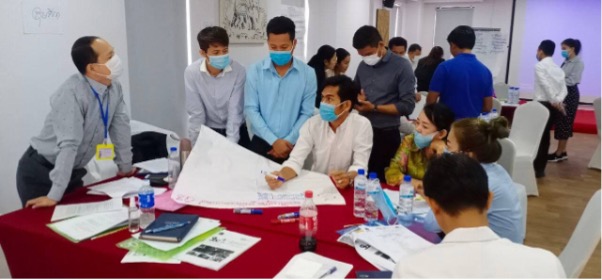
On 25th to 27th of January 2021, the ILO and Cambodia’s Ministry of Tourism (MoT) organized a three-day training for facilitators on entrepreneurship in the tourism sector. The training on the ‘Methodology of Training on Entrepreneurship in the Tourism Sector’ brought together 45 participants (15 females) who learned key business and entrepreneurial skills to build back the industry.
Due to the ongoing COVID-19 pandemic and travel restrictions, Cambodia’s tourism sector has been heavily impacted. Strengthening the capacity and conditions of SMEs in the industry is crucial for sustainable recovery as the ministry looks to restart tourism after the crisis. The training, held in Phnom Penh, taught ILO’s Community-Based Enterprise Development (C-BED) programme, an innovative business development project for aspiring entrepreneurs in underserved communities. The peer-learning programme teaches critical steps to build and develop a business, as well as strengthening decision-making, planning and finances. The activity-based learning methods of training builds on the experience of fellow participants which ensures flexibility to the evolving needs of industry and workers during difficult times.
Participants learned how to facilitate their own sessions and pass on vital entrepreneurial skills to the wider tourism community. By expanding the quantity and quality of professional entrepreneurial skills in the industry, the tourism sector can recover and become more resilient in the future.

MoT and ILO acknowledged this training was aligned with and contributed to achieving the Strategic Plan for Tourism Human Resource Development 2017-2025, especially the Strategic Plan for Restarting Tourism 2021-2025. The participants of this training programme will deliver practical skills and knowledge to tourism business operators in different provinces with using the new training method of activity-based learning. MoT and ILO will continue working together to sustainably improve entrepreneurship in the tourism sector along with the ongoing direction and action plan for future.
This activity was supported by the Decent Employment for Youth in Cambodia programme, which is a UN joint programme primarily funded by Swiss Agency for Development and Cooperation (SDC), as well as the ILO/Japan Fund for Building Social Safety Nets in Asia and the Pacific (SSN Fund).
To learn more about C-BED and activity-based learning, click here .
More updates
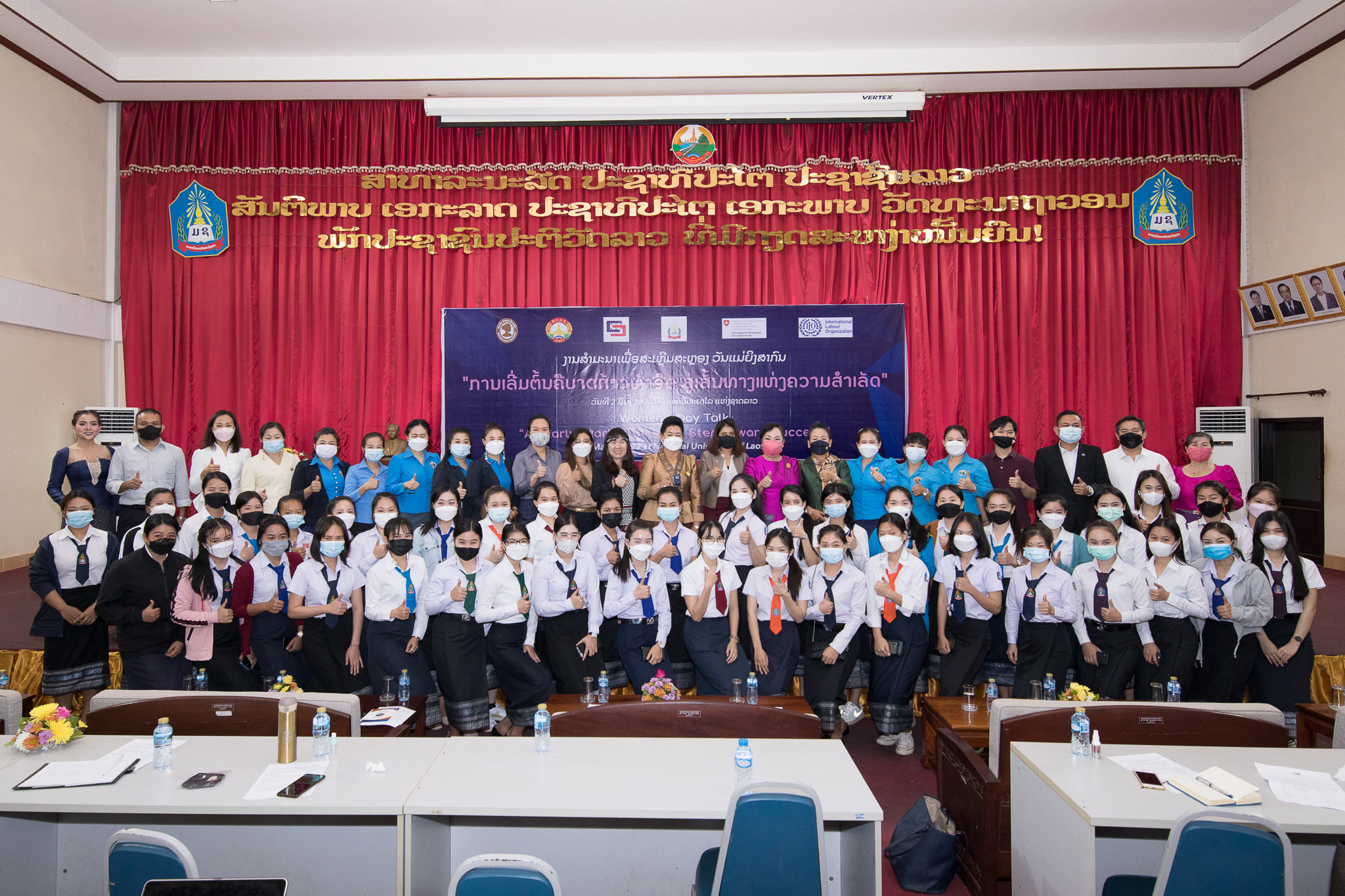
International Women’s Day 2022: Empowering Lao PDR’s young women as the future of entrepreneurship

Women entrepreneurs connect across ASEAN
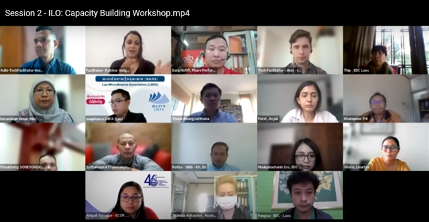
Equipping online facilitation skills to better support MSMEs during and beyond the COVID-19 pandemic
Useful Resources
- Tourist Information Center
- CBET Destinations
- Advice for Travelers
- Where to Shop
- Public Holidays
- Currency Exchange
- Video & Tourism Spot
- Weather & Forecast
- Tourism Law
The Kingdom of Cambodia has plenty to offer in each of our 25 wonderful locations. Phnom Penh being the Capital City and 24 provinces, each bubbling with their respective excitements and flavours awaiting to be explored and enjoyed.

CBT Destinations
Community-based tourism (CBT) is a form of responsible tourism that supports local communities and improves livelihoods. The tourism destination is managed by the local community members themselves.
With general tourism, visits are often marketed and organized by private travel companies. The bulk of the profits leave the community, and only a few private individuals may benefit from the enterprise. In contrast, CBT is managed and run by the community members themselves. All of the management decisions are made by, or in consultation with the community, and all of the profits directly benefit the local community.
The main positive impacts include benefit sharing among the community members, community participation, community control, empowerment and conservation. By managing the interactions between the host and the visitors, the negative impacts of tourism to the community and environment can be minimized.
Community-based ecotourism (CBET) addresses the well-being of the community and the surrounding environment. While supporting local communities and improving livelihoods, the natural and cultural resources of the area are protected and conserved. Ecotourism is a type of sustainable tourism in which tourists experience, appreciate and enjoy the nature and culture of their destination. The negative impacts of tourism are minimized while an incentive for conserving natural and cultural features is provided.
CBET helps protect nature and support the lives of the local community. It provides alternative income which encourages the community to protect its natural resources rather than destroy them through unsustainable use.
Through CBET visitors get the change to have to know local Cambodian people, enjoy their hospitality, join them in their everyday life and learn about their culture and environment. This authentic form of tourism takes visitors to their communities and beautiful natural areas. Come and experience the real culture, the real nature and the real Cambodia.
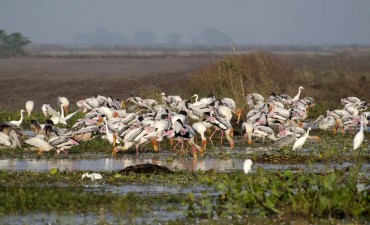
Ang Trapeang Thmor Community-Based Ecotourism Site
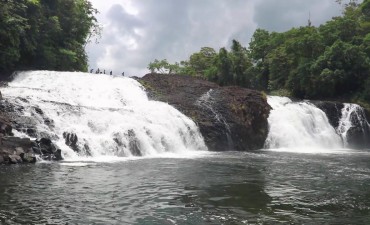
Chi Phat Community-Based Ecotourism Site
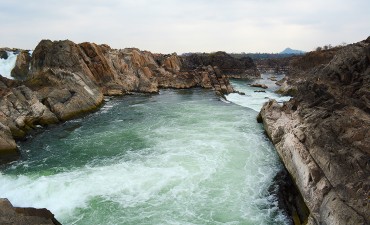
Preah Rumkel Community-Based Ecotourism Site
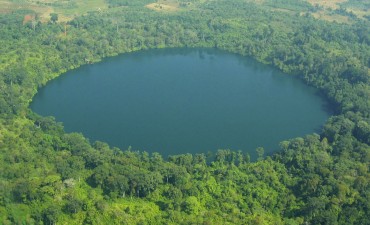
Yeak Laom Community-Based Ecotourism Site
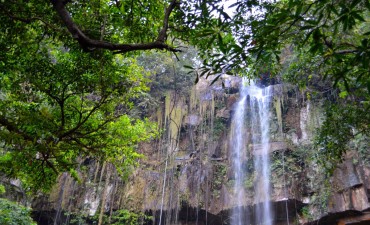
Chambok Community-Based Ecotourism Site
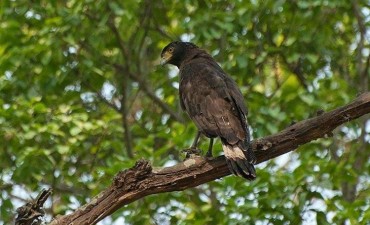
Thmatboey Community-Based Ecotourism Site
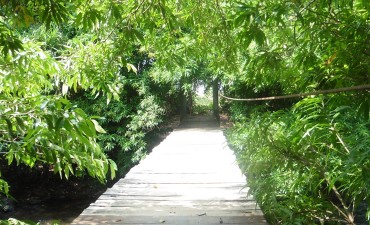
O'Russey Kandal Community-Based Ecotourism Site
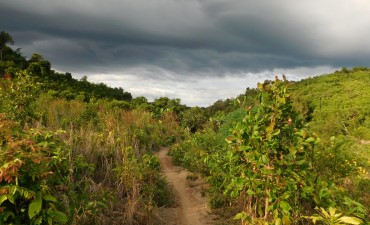
Virachey National Park Community-Based Ecotourism Initiative
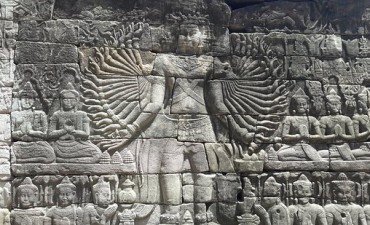
Banteay Chhmar Community-Based Tourism Site
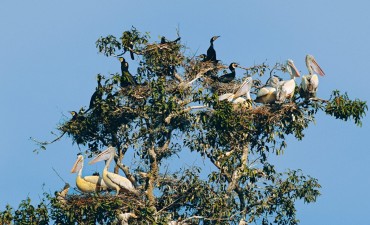

Prek Toal Community-Based Ecotourism Site
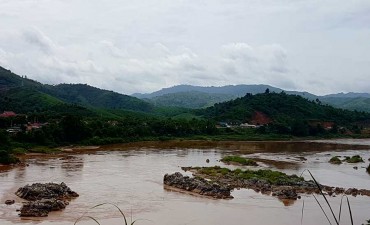
Koh Pdao Community Development Tour
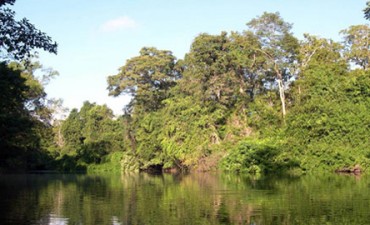
Osvay Community-Based Ecotourism Site
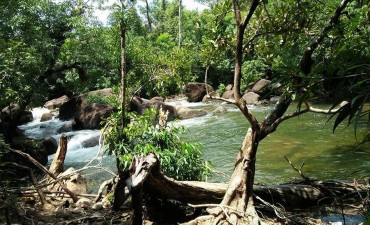
Prek Thnout Community-Based Ecotourism Site
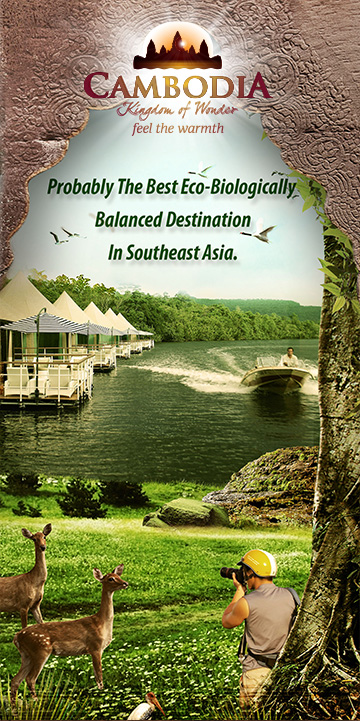
Provincial Guides
Phnom Penh (Capital City) Rattanakiri Mondulkiri Siem Reap Preah Sihanouk Stung Treng Kratie Preah Vihear Kampot Kep Koh Kong Kampong Thom Kandal Takeo Battambang Kampong Cham Kampong Chhnang Kampong Speu Pursat Oddar Meanchey Pailin Prey Veng Svay Rieng Banteay Meanchey Tbong Khmum
This website, Tourismcambodia.org, the official website of Ministry of Cambodia of the Kingdom of Cambodia, is designed and maintained collaboratively by RED DOT (Cambodia) Co., Ltd and Cybernetics Ltd a full service branding and advertising agency in Cambodia. While efforts are made to ensure that all the information hereto are good, accurate and up to date, by visiting the website Tourismcambodia.org, viewing, accessing or otherwise using any of the services or information created, collected, compiled or submitted to Tourismcambodia.org, you agree to be bound by the our Terms and Conditions of Use, (Click here). If you do not want to be bound by our Terms, your only option is not to visit, view or otherwise use the services of Tourismcambodia.org. You understand, agree and acknowledge that these Terms constitute a legally binding agreement between you and Tourismcambodia.org and that your use of Tourismcambodia.org shall indicate your conclusive acceptance of this agreement.
© 2024 | DESIGNED & HOSTED BY: RED DOT (CAMBODIA) CO., LTD | All Rights Reserved. Disclaimer

How the Tourism Boom in Cambodia Has Impacted Urban Poverty
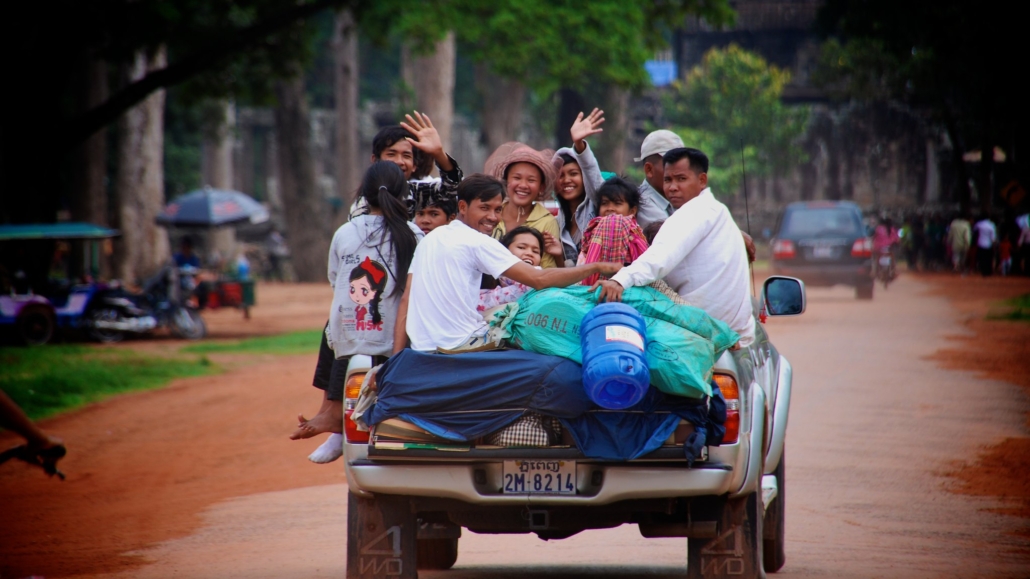
The Economic Impact
In the first seven months of 2023, Cambodia welcomed 409% more international visitors, a significant growth compared to the same period in 2022. The tourism boom in Cambodia has caused a significant economic boost in the urban centers, particularly in cities like Siem Reap and Phnom Penh. The rise in tourist arrivals has led to a surge in demand for services, creating employment opportunities in many sectors, such as hospitality, transportation and retail.
Employment Opportunities
One of the most visible impacts of the tourism boom in Cambodia is the increase in job opportunities. Specifically, the hospitality sector, including hotels, restaurants and tour guides, has experienced significant growth, providing jobs for a large portion of the urban workforce. Due to the growth of this sector, there was an increased demand for specialized training. In 2023, the Ministry of Tourism responded by providing hospitality training to approximately 4,106 young people from economically disadvantaged families. These trainings took place across 10 Cambodian provinces and helped to strengthen the hospitality sector.
Entrepreneurial Opportunities
Beyond traditional employment, the tourism boom in Cambodia has spurred entrepreneurial activities. Many individuals have taken the opportunity to establish small businesses catering to the needs and preferences of tourists. In fact, in the first 11 months of 2023, the Ministry of Commerce recorded 11,056 new businesses. This number showed an increase of about 15% in new businesses compared to the previous year.
Infrastructure Development
Recognizing the potential of tourism as a cause of economic growth, the Cambodian government has invested significantly in infrastructure development. Remote communities, previously isolated due to inefficient transportation networks, are now much better connected. As a result, economic development is fostered with new markets for local products and creating trade opportunities.
Community Development
The positive impact of the tourism boom in Cambodia goes far beyond the economic realm, benefitting community development and social welfare. As tourism revenue flows into the country, the Cambodian government and local authorities have increasingly directed these profits toward needed services, such as education and health care.
Tourism revenue has been channeled into building schools, providing scholarships and improving educational infrastructure. Similarly, the health care sector has received much-needed attention. Medical facilities in regions with a high influx of tourists have been enhanced, ensuring that both local residents and visitors have access to quality health care services.
Overall, the boom in Cambodia tourism has generated a large profit. This revenue has helped create new job opportunities, enhance infrastructure and improve the quality of life for impoverished communities in the country.
– Trisha Borde Photo: Flickr
“The Borgen Project is an incredible nonprofit organization that is addressing poverty and hunger and working towards ending them.”
-The Huffington Post
Inside the borgen project.
- Board of Directors
International Links
- UK Email Parliament
- UK Gaza Ceasefire
- Canada Email Parliament
- Canada Gaza Ceasefire
Get Smarter
- Global Poverty 101
- Global Poverty… The Good News
- Global Poverty & U.S. Jobs
- Global Poverty and National Security
- Innovative Solutions to Poverty
- Global Poverty & Aid FAQ’s
Ways to Help
- Call Congress
- Email Congress
- 30 Ways to Help
- Volunteer Ops
- Internships
- Courses & Certificates
- The Podcast

Navigating uncertainty: Cambodian tourism businesses and the pandemic

Marly Augustine

Streets crowded with tuk-tuks carrying visitors to Angkor Wat; bustling restaurants and bars; hotels and guesthouses pre-booked for the Water Festival – these scenes vanished when the COVID-19 pandemic stopped international and domestic tourists from visiting Cambodia’s sights.
Although the country’s public health situation was comparably unscathed throughout 2020 – Cambodia recorded only 331 active cases and no deaths by November 2020 – movement restrictions decreased household incomes by 30 to 60%. The situation escalated in 2021 when Cambodia went from a few cases to more than 60,000 by mid-July 2021.
Contributing over 70% of jobs and 58% of GDP in 2018, Cambodia’s micro-, small and medium-size enterprises (MSMEs) have been profoundly affected by the pandemic. The tourism industry, Cambodia’s second-largest driver of economic growth and where many MSMEs work, is especially in crisis. In 2019, tourism generated about US$4.9 billion, nearly 20% of the country’s GDP , while COVID-affected 2020 saw international tourism revenue plummet nearly 80%, to US$1.023 billion.
In 2020 and 2021, to understand the impact of COVID-19 on small businesses in the region, The Asia Foundation collaborated with local partners in carrying out multiple surveys of MSMEs in tourism, handicrafts, manufacturing and other industries across Cambodia, Lao People’s Democratic Republic, Malaysia, Myanmar, Thailand, and Timor-Leste.
In July and November 2020 and in April 2021, we also surveyed registered and unregistered businesses in Cambodia’s tourism sector. The surveys indicated that 99% had been affected by the pandemic and lockdowns, with over 50% severely affected in April 2021. As COVID-19 restrictions were extended, the situation worsened: 54% of respondents reported cash flow problems in November 2020, increasing to 83% by April 2021.
The surveys revealed a link between national COVID-19 caseloads, perceptions around business survivability, and adaptation efforts. In Cambodia, a slight majority of surveyed businesses considered COVID-19 a threat to their operations in July and November 2020, when caseloads were low, but by April 2021 more than three-quarters of businesses viewed the pandemic as a serious threat.
In July 2020, 40% of Cambodian tourism businesses reported pandemic-related layoffs, while 60% had held steady. Only 16% reported letting staff go between July and November. Instead, many had decreased employee hours or were rotating hours to keep workers. However, by April 2021, facing greater restrictions and a worsening public health crisis, 33% of Cambodian tourism businesses reported having laid off employees – twice as many as in November.
Idled tourism workers sought any short-term work opportunities to make ends meet. In Siem Reap, the gateway to Angkor Wat and other attractions, many women – who were disproportionately affected by layoffs – left the city, hoping to find jobs in the garment industry in Phnom Penh. Unfortunately, COVID-19 containment measures caused the garment factories to close.
After the first lockdown in April 2020, street vendors, taxi drivers, and tuk-tuk drivers felt less affected by the pandemic because domestic tourism and daily life continued. However, as pandemic restrictions grew and activity declined, many male tuk-tuk drivers turned to construction work – only to see worksites close in April 2021 lockdowns, leaving some with only half that month’s salary in hand.
Many Cambodian tourism MSMEs were unable to adapt their business models to digital methods. Only 8% reported doing increased business online by April 2021. Some food-related businesses, such as restaurants and street vendors in Phnom Penh, generated income through online delivery platforms. However, online is not an option for tourism businesses that cannot offer takeout food or virtual services.
Since the crisis began, Southeast Asian governments have provided a range of packages to support businesses in weathering the pandemic. However, communication about assistance and how to access it has often been inadequate.
Cambodia has provided direct support, such as cash for laid-off workers, and indirect support, such as debt restructuring. Unregistered businesses do not currently qualify for support, yet they make up a large share of employers and workers.
Although Cambodia was relatively successful in disseminating information to registered businesses compared to other countries in the region, only about 50% of MSMEs surveyed had enrolled and received needed assistance. Some said they lacked information on the programs, especially process and eligibility details, while others found the application procedures difficult to navigate.
The initial optimism of many Southeast Asian MSMEs for a 2021 economic recovery has been dampened by the latest wave of COVID-19. Despite this, Cambodia may see a quicker return to normal due to one of the highest vaccination rates in the region.
Governments must prioritise vaccine rollout, and plan for an uncertain future, in order to mitigate the economic fallout of COVID-19 containment strategies. Financial assistance for MSMEs can help negate the worst of the effects and prolong business survival. But to be effective, coverage needs to include both registered and unregistered businesses.
Beyond existing support mechanisms, governments must provide targeted and tailored assistance for women, young people, and contract and informal workers – those most adversely affected by the economic fallout. A strong and inclusive economic recovery will require more than online access and minor business adaptations – it will demand greater attention to these differential dynamics, better communication and outreach to MSMEs, and larger safety nets while scaling up vaccination.
Read the Cambodia surveys . Read the latest GovAsia issue 1.3 about the impact of COVID-19 on MSMEs across Southeast Asia . Find individual country survey reports .
This post is part of a collaborative series with The Asia Foundation .
This article draws on research exploring the impacts of COVID-19 on Cambodian MSMEs in the tourism sector and households in Cambodia. The research was completed in partnership with Angkor Research and Consulting, Centre for Policy Studies, and Future Forum, and was funded under a partnership between The Asia Foundation’s United States Congressional Appropriation; Department of Foreign Affairs and Trade (DFAT), Australia; and Ministry of Foreign Affairs and Trade (MFAT), New Zealand through the Ambassador Fund. The views expressed are those of the authors only.
Share this post
Contributors.

Men Pechet is a Program Manager in The Asia Foundation’s Cambodia Office.

Marly Augustine is a consultant with The Asia Foundation’s Governance, and Evaluation and Learning Units.
Leave a comment Cancel Reply
Sign me up for the fortnightly newsletter!
Don't subscribe All new comments Replies to my comments Notify me of followup comments via e-mail. You can also subscribe without commenting.
Related Posts

Upcoming events
3-5 December 2024 2024 Australasian AID Conference Crawford School of Public Policy, ANU
Posted on September, 14 2022
You are using an outdated browser. Please upgrade your browser to improve your experience.
Home — Essay Samples — Geography & Travel — Tourism — The Positive and Negative Impacts of Tourism on Cambodia
The Positive and Negative Impacts of Tourism on Cambodia
- Categories: Tourism
About this sample

Words: 1042 |
Published: Jul 10, 2019
Words: 1042 | Pages: 2 | 6 min read
Table of contents
Positive effects of tourism in cambodia, negative effects of tourism in cambodia, positive and negative impacts of tourism on the environment of cambodia, works cited.
- Conservation Efforts: Revenue generated from tourism has been channeled into conservation initiatives aimed at protecting Cambodia's natural and cultural heritage sites. This includes funding for the preservation of historical temples like Angkor Wat and the conservation of biodiversity in national parks.
- Reforestation: In some regions, tourism-driven conservation projects have led to reforestation efforts, helping to restore damaged ecosystems and combat deforestation.
- Deforestation: The growth of tourism has contributed to deforestation in Cambodia, particularly in areas near popular destinations like Siem Reap. Forests are cleared to make way for infrastructure development, such as hotels and roads, resulting in habitat loss for numerous plant and animal species.
- Pollution: Increased tourist activities have led to higher levels of pollution, including water pollution from sewage and waste disposal. This pollution can harm aquatic ecosystems and water quality, affecting both wildlife and local communities.
- Habitat Destruction: Construction of tourist facilities, such as resorts and golf courses, often involves the destruction of natural habitats. This can disrupt the ecosystems that support Cambodia's unique and diverse wildlife.
- Overuse of Natural Resources: The demand for water, energy, and other resources in tourist areas can strain local supplies, leading to over-extraction of resources and exacerbating scarcity in already vulnerable regions.
- Soil Erosion: Activities related to tourism, such as hiking and off-road vehicle tours, can contribute to soil erosion, further degrading natural landscapes.
- Wildlife Exploitation: The demand for wildlife-based tourism activities, such as elephant rides and visits to wildlife sanctuaries, can contribute to the illegal wildlife trade and the mistreatment and endangerment of animals.
- Nhean, P. (2013). 'The Kingdom of Wonder': Cambodia's Destination Branding. In R. Raj & G. Musa (Eds.), Tourism Development in Asia (pp. 139-153). Channel View Publications.
- Royal Government of Cambodia (RGC). (2012). Cambodia Tourism Marketing Strategy 2012-2020. Ministry of Tourism, Cambodia.
- World Travel and Tourism Council. (2016). Travel & Tourism Economic Impact 2016 Cambodia. World Travel and Tourism Council.
- Meng, K., & Nhean, P. (2018). Chinese Tourists Driving Southeast Asia Airport Boom. Nikkei Asian Review.
- Ma, A., & Cripps, K. (2017). Angkor Wat: Tourists behaving badly at Cambodia's sacred site. CNN Travel.
- Fifield, A. (2018). Cambodia’s Chinese tourism boom sparks concerns over impact. Financial Times.
- World Bank. (2019). Cambodia: Maximizing the Benefits of Tourism for Inclusive Development. World Bank Group.

Cite this Essay
To export a reference to this article please select a referencing style below:
Let us write you an essay from scratch
- 450+ experts on 30 subjects ready to help
- Custom essay delivered in as few as 3 hours
Get high-quality help

Dr. Heisenberg
Verified writer
- Expert in: Geography & Travel

+ 120 experts online
By clicking “Check Writers’ Offers”, you agree to our terms of service and privacy policy . We’ll occasionally send you promo and account related email
No need to pay just yet!
Related Essays
5 pages / 2162 words
1 pages / 618 words
1 pages / 586 words
7 pages / 2958 words
Remember! This is just a sample.
You can get your custom paper by one of our expert writers.
121 writers online
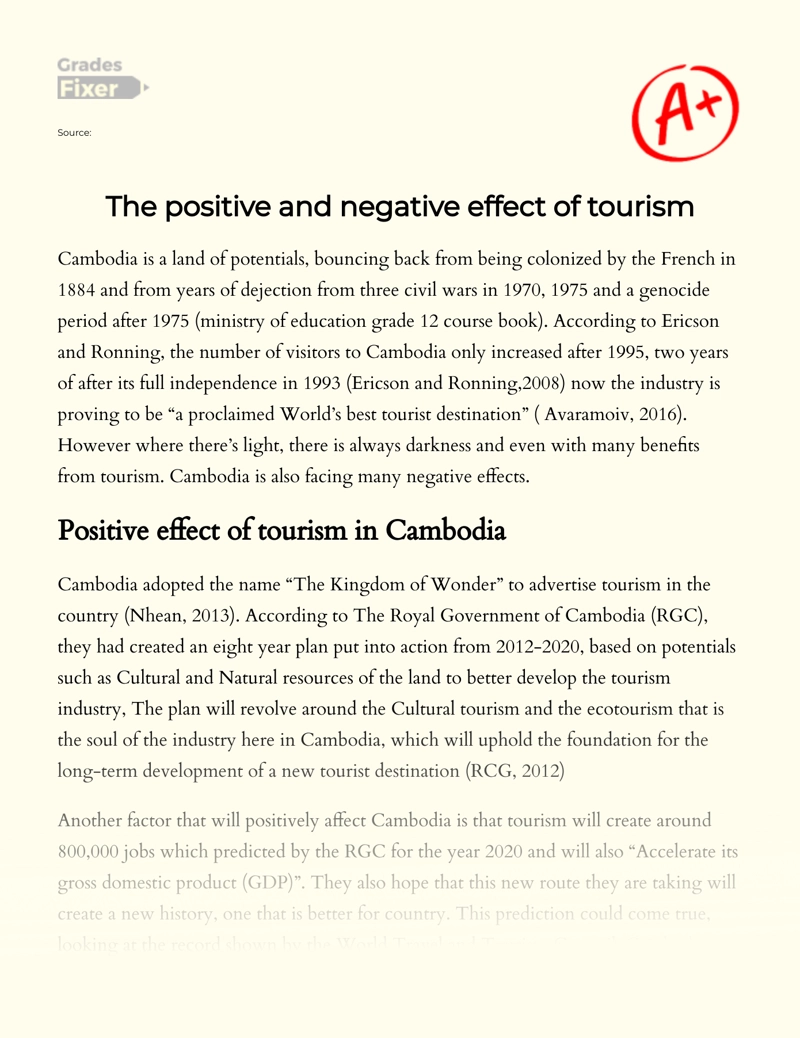
Still can’t find what you need?
Browse our vast selection of original essay samples, each expertly formatted and styled
Related Essays on Tourism
In summation, the adventure trip to Patagonia served as an embodiment of the transformative power of exploration. Beyond the picturesque landscapes and physical challenges, the journey offered a holistic experience that [...]
The Grand Canyon, a colossal chasm carved by the Colorado River in the state of Arizona, United States, stands as one of the most majestic and awe-inspiring natural wonders of the world. This geological marvel, with its [...]
Florida, the Sunshine State, is a place that holds a special place in my heart. It is not just the year-round warm weather that attracts me, but a combination of natural beauty, cultural diversity, and a unique lifestyle that [...]
Machu Picchu, often referred to as the "Lost City of the Incas," is one of the most iconic and well-preserved archaeological sites in the world. Perched high in the Andes Mountains of Peru, this ancient Incan city has [...]
Greece is more than what it seems. Have you ever thought that just maybe, even if it’s for a second that you could got to Greece. Thinking about it why wouldn’t you want to go there. Atlas once that sec on is over you think of [...]
Tourism is travel for pleasure or business; also the theory and practice of touring, the business of attracting, accommodating, and entertaining tourists, and the business of operating tours. Tourism may be international, or [...]
Related Topics
By clicking “Send”, you agree to our Terms of service and Privacy statement . We will occasionally send you account related emails.
Where do you want us to send this sample?
By clicking “Continue”, you agree to our terms of service and privacy policy.
Be careful. This essay is not unique
This essay was donated by a student and is likely to have been used and submitted before
Download this Sample
Free samples may contain mistakes and not unique parts
Sorry, we could not paraphrase this essay. Our professional writers can rewrite it and get you a unique paper.
Please check your inbox.
We can write you a custom essay that will follow your exact instructions and meet the deadlines. Let's fix your grades together!
Get Your Personalized Essay in 3 Hours or Less!
We use cookies to personalyze your web-site experience. By continuing we’ll assume you board with our cookie policy .
- Instructions Followed To The Letter
- Deadlines Met At Every Stage
- Unique And Plagiarism Free
- The Third Tracer Study Reveals Key Insights into Employability and Training Outcomes
The Third Tracer Study Reveals Key Insights into Employability and Training Outcomes
Background of the study.
The SDP strives to increase access to quality training for disadvantaged young women and men and to help them secure employment. To assess the outcomes of the SDP-supported training, tracer studies are conducted with graduates 6 and 12 months after completing their courses. These studies evaluate the relevance and effectiveness of skills training for the workplace.
This final tracer study of the SDP Phase 2 surveyed a range of graduate cohorts, including those who completed their training 6 months, 12 months and 2 years ago. It also gathered feedback from employers and training provider partners such as the Provincial Training Centres (PTCs), Technical Training Institutes (TTIs) and Provincial Departments of Tourism (PDoT) to measure the wider impact of the training interventions. The study was conducted using both face-to-face and telephone surveys.
Study Objectives
The main objectives of the tracer study were to analyse and understand:
- The quality and relevance of the post-training support provided to graduates.
- The employment status and income of graduates.
- Employment progress from 6 to 12 months after graduation.
- The relevance of the skills training for the workplace.
- Improvements of working conditions.
- Other perceived benefits of the training programmes.
Study Framework
The study utilised questionnaires developed based on specific objectives and performance indicators. These indicators measured graduate satisfaction, employment status, skills improvement, income changes, and relevance of training to the workplace. Additional indicators were used to assess employer satisfaction with graduate competencies and willingness to participate in future training initiatives.
Scope and Methodology
The study was conducted using a stratified random sampling technique, targeting graduates and employers across a range of sectors. The sample size was determined based on population size, confidence levels and response distribution. The data collection process involved digital questionnaires administered via telephone surveys and face-to-face interactions, with data analysis performed using Microsoft Power BI for visualisation.
The study included three main groups:
- Graduates from different cohorts (6-month, 12-month and first batch graduates).
- Employers who recruited graduates, including those in the hospitality sector (HoKa).
- Trainers and managers from public partners such as PTCs, TTIs and PDoT
Survey Findings
The third round of the tracer study confirms that the training programmes supported by the SDP continue to have a positive impact on the employability and career progression of graduates. Employers in various sectors, particularly in the hospitality industry, reported satisfaction with the skills and competencies of graduates. Trainers and managers also noted improvements in their professional skills and institutional development, contributing to the overall success of the SDP Phase 2.
- Share this page on LinkedIn
- Share this page on facebook
- Share on twitter
- Share by e-mail
Spatio-temporal evolution characteristics and spatial spillover effects of forest carbon sink efficiency in China
- Published: 22 September 2024
Cite this article

- Liping Wang 1 ,
- Longjun Chen 1 ,
- Ying Long 1 &
- Chuang Li 2
61 Accesses
Explore all metrics
This study developed a super efficiency Slacks-Based Measure model to quantitatively measure the forest carbon sink efficiency (FCSE) of 30 provinces (cities) in China from 2005 to 2020, analyzed its spatio-temporal evolution characteristics, and used a spatial Durbin model to examine the spatial spillover effects of FCSE. The results indicate that: ① The overall FCSE exhibits a fluctuating upward trend in China. From the perspective of forest regions, the FCSE values in the southwest and northeast forest regions are higher than the national average, whereas those in the north and northwest forest regions are lower. From the perspective of spatial distribution, China's FCSE showed distinct characteristics of agglomeration and continuity, with high efficiency zone gradually expanding and low efficiency zone shrinking. ② China's FCSE has significant spatial spillover effect, shifting from "high-high" and "low-high" agglomerations to "high-high" and "low-low" agglomerations. In summary, economic development level, forest harvesting volume, urbanization rate, and land use structure have significant positive spillover effects on the FCSE of neighboring provinces.
This is a preview of subscription content, log in via an institution to check access.
Access this article
Subscribe and save.
- Get 10 units per month
- Download Article/Chapter or eBook
- 1 Unit = 1 Article or 1 Chapter
- Cancel anytime
Price includes VAT (Russian Federation)
Instant access to the full article PDF.
Rent this article via DeepDyve
Institutional subscriptions

Similar content being viewed by others

Evaluation of Forestry Industry Agglomeration and Regional Different Analysis in China's Southern Collective Forest Region
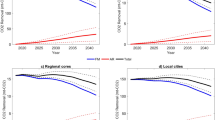
Forest carbon removal potential and sustainable development in Japan

Examining the spatiotemporal change of forest resource carrying capacity of the Yangtze River Economic Belt in China
Bañolas, G., Fernández, S., Espino, F., et al. (2020). Evaluation of carbon sinks by the seagrass Cymodocea nodosa at an oceanic island: Spatial variation and economic valuation. Ocean & Coastal Management, 187 , 105112. https://doi.org/10.1016/j.ocecoaman.2020.10511
Article Google Scholar
Behera, B., Behera, P., & Sethi, N. (2024a). Decoupling the role of renewable energy, green finance and political stability in achieving the sustainable development goal 13: Empirical insight from emerging economies. Sustainable Development, 32 (1), 119–137. https://doi.org/10.1002/sd.2657
Behera, B., Sucharita, S., Patra, B., et al. (2024b). A blend of renewable and non-renewable energy consumption on economic growth of India: The role of disaggregate energy sources. Environmental Science and Pollution Research, 31 , 3902–3916. https://doi.org/10.1007/s11356-023-31372-0
Behera, P., Behera, B., Sethi, N., et al. (2024c). What drives environmental sustainability? The role of renewable energy, green innovation, and political stability in OECD economies. International Journal of Sustainable Development & World Ecology . https://doi.org/10.1080/13504509.2024.2333812
Cao, J. X., Tian, Y., Wang, X. P., et al. (2009). Estimation method and development trend of forest carbon sink. Ecology and Environmental Sciences, 18 (5), 2001–2005. https://doi.org/10.16258/j.cnki.1674-5906.2009.05.033
Chen, G. (2015). Research on the economic value evaluation of China’s forest carbon sinks. Price: Theory & Practice, 5 , 109–111. https://doi.org/10.19851/j.cnki.cn11-1010/f.2015.05.035
Chen, R., Ye, C., Cai, Y., et al. (2014). The impact of rural out-migration on land use transition in China: Past, present and trend. Land Use Policy, 40 , 101–110. https://doi.org/10.1016/j.landusepol.2013.10.003
Cunha, S. K. D., & Cunha, J. C. D. (2005). Tourism cluster competitiveness and sustainability: Proposal for a systemic model to measure the impact of tourism on local development. BAR-Brazilian Administration Review, 2 , 47–62. https://doi.org/10.1590/S1807-76922005000200005
Daigneault, A., & Favero, A. (2021). Global forest management, carbon sequestration and bioenergy supply under alternative shared socioeconomic pathways. Land Use Policy, 103 , 105302. https://doi.org/10.1016/j.landusepol.2021.105302
Diswandi, D. (2017). A hybrid Coasean and Pigouvian approach to payment for ecosystem services program in West Lombok: Does it contribute to poverty alleviation? Ecosystem Services, 23 , 138–145. https://doi.org/10.1016/j.ecoser.2016.12.005
Ercanli, İ. (2018). Positive effect of forest structural diversity on aboveground stand carbon stocks for even-aged Scots pine (Pinus sylvestris L.) stands in the Sarıçiçek Forest, Northern Turkey. Scandinavian Journal of Forest Research, 33 (5), 455–463. https://doi.org/10.1080/02827581.2018.1444196
Ge, J., Zhang, Z. J., & Lin, B. (2023). Towards carbon neutrality: How much do forest carbon sinks cost in China? Environmental Impact Assessment Review, 98 , 106949. https://doi.org/10.1016/j.eiar.2022.106949
Grassi, G., House, J., Dentener, F., et al. (2017). The key role of forests in meeting climate targets requires science for credible mitigation. Nature Climate Change, 7 (3), 220–226. https://doi.org/10.1038/nclimate3227
Gu, X., Qin, L., & Zhang, M. (2023). The impact of green finance on the transformation of energy consumption structure: Evidence based on China. Frontiers in Earth Science, 10 , 1097346. https://doi.org/10.3389/feart.2022.1097346
Guswa, A. J. (2008). The influence of climate on root depth: a carbon cost-benefit analysis. Water Resources Research, 44 (2), 159–167. https://doi.org/10.1029/2007WR006384
Håbesland, D. E., Kilgore, M. A., Becker, D. R., et al. (2016). Norwegian family forest owners’ willingness to participate in carbon offset programs. Forest Policy and Economics, 70 , 30–38. https://doi.org/10.1016/j.forpol.2016.05.017
He, X., Chen, L., & Huang, Y. (2022). A study of forest carbon sink increment from the perspective of efficiency evaluation based on an inverse DEA model. Forests, 13 (10), 1563. https://doi.org/10.3390/f13101563
Heinrich, V. H. A., Dalagnol, R., Cassol, H. L. G., et al. (2021). Large carbon sink potential of secondary forests in the Brazilian Amazon to mitigate climate change. Nature Communications, 12 (1), 1785. https://doi.org/10.1038/s41467-021-22050-1
Article CAS Google Scholar
Jia, S. W. (2016). Research on forest carbon storage and its economic value in Henan province based on forest resource inventory data. Hubei Agricultural Sciences, 55 (6), 1612–1616. https://doi.org/10.14088/j.cnki.issn0439-8114.2016.06.061
Ken, S., Entani, T., Tsusaka, T. W., & Sasaki, N. (2020). Effect of REDD+ projects on local livelihood assets in Keo Seima and Oddar Meanchey. Cambodia. Heliyon, 6 (4), e03802. https://doi.org/10.1016/j.heliyon.2020.e03802
Kong, Y., He, W., Shen, J., et al. (2023). Adaptability analysis of water pollution and advanced industrial structure in Jiangsu Province. China. Ecological Modelling, 481 , 110365. https://doi.org/10.1016/j.ecolmodel.2023.110365
Kumari, M., Sarma, K., & Sharma, R. (2019). Using Moran’s I and GIS to study the spatial pattern of land surface temperature in relation to land use cover around a thermal power plant in Singrauli district, Madhya Pradesh, India. Remote Sensing Applications: Society and Environment, 15 , 100239. https://doi.org/10.1016/j.rsase.2019.100239
Lan, H. X., & Zhao, X. Y. (2020). The space-time evolution of China’s regional innovation efficiency and the impact factors of innovation environment. Economic Geography, 40 (2), 97–107. https://doi.org/10.15957/j.cnki.jjdl.2020.02.011
Lee, J., & Li, S. (2017). Extending moran’s index for measuring spatiotemporal clustering of geographic events. Geographical Analysis, 49 (1), 36–57. https://doi.org/10.1111/gean.12106
Levy-Varon, J. H., Batterman, S. A., Medvigy, D., et al. (2019). Tropical carbon sink accelerated by symbiotic dinitrogen fixation. Nature Communications, 10 (1), 5637. https://doi.org/10.1038/s41467-019-13656-7
Li, C., Wang, X., & Wang, L. (2024a). Interplay of virtual and physical channels in propagating green behaviour: A study integrating motivation-opportunity-ability and theory of planned behaviour. Environmental Development, 50 , 100997. https://doi.org/10.1016/j.envdev.2024.100997
Li, C., Zhang, G., & Wang, L. (2024b). Spatio-temporal evolution and scenario analysis of end-recycling governance in China: Based on GM-SVR-BP combined forecasting model. Energy Sources, Part a: Recovery, Utilization, and Environmental Effects, 46 (1), 4733–4755. https://doi.org/10.1080/15567036.2024.2327602
Li, M. (2022). Carbon stock and sink economic values of forest ecosystem in the forest industry region of Heilongjiang province. China. Journal of Forestry Research, 33 (3), 875–882. https://doi.org/10.1007/s11676-021-01347-3
Liang, L., Wang, Z., & Li, J. (2019). The effect of urbanization on environmental pollution in rapidly developing urban agglomerations. Journal of Cleaner Production, 237 , 117649. https://doi.org/10.1016/j.jclepro.2019.117649
Lin, B., & Ge, J. (2019a). Carbon sink and output of China’s forestry sector: An ecological economic development perspective. Science of the Total Environment, 655 , 1169–1180. https://doi.org/10.1016/j.scitotenv.2018.11.219
Lin, B., & Ge, J. (2019b). Valued forest carbon sinks: How much emissions abatement costs could be reduced in China. Journal of Cleaner Production, 224 , 455–464. https://doi.org/10.1016/j.jclepro.2019.03.221
Lin, G., Jiang, D., Li, X., et al. (2022). Accounting for carbon sink and its dominant influencing factors in Chinese ecological space. Land, 11 (10), 1822. https://doi.org/10.3390/land11101822
Linghu, D. Z., Luo, X., & Zhu, B. Z. (2022). Research progress in forest carbon sink calculation and carbon sequestration impact factors. Journal of Guangxi University (Philosophy and Social Science), 44 (3), 142–155. https://doi.org/10.13624/j.cnki.jgupss.2022.03.021
Liu, J., Ren, Y., Hong, Y., et al. (2023). Does forest farm carbon sink projects affect agricultural development? Evidence from a Quasi-experiment in China. Journal of Environmental Management, 335 , 117500. https://doi.org/10.1016/j.jenvman.2023.117500
Liu, S., Zhang, X., Zhou, Y., & Yao, S. (2021). Spatiotemporal evolution and influencing factors of carbon sink dynamics at county scale: A case study of Shaanxi province, China. International Journal of Environmental Research and Public Health, 18 (24), 13081. https://doi.org/10.3390/ijerph182413081
Liu, S. N., Zhou, T., Wei, L. Y., et al. (2012). The spatial distribution of forest carbon sinks and sources in China. Chinese Science Bulletin, 57 , 1699–1707. https://doi.org/10.1007/s11434-012-4998-1
Lu, Y., Yue, W., He, T., et al. (2022). Urban form centrality and thermal environment: An empirical study of Chinese megacities. Sustainable Cities and Society, 83 , 103955. https://doi.org/10.1016/j.scs.2022.103955
Mardani, A., Zavadskas, E. K., Streimikiene, D., et al. (2017). A comprehensive review of data envelopment analysis (DEA) approach in energy efficiency. Renewable and Sustainable Energy Reviews, 70 , 1298–1322. https://doi.org/10.1016/j.rser.2016.12.030
Moon, T., Kim, M., & Chon, J. (2024). Adaptive green space management strategies for sustainable carbon sink parks. Urban Forestry & Urban Greening, 94 , 128236. https://doi.org/10.1016/j.ufug.2024.128236
Pan, R., Shen, Y. Q., Yang, H., et al. (2020). Research on China’s forest carbon sink demand. Issues of Forestry Economics, 40 (1), 14–20. https://doi.org/10.16832/j.cnki.1005-9709.2020.01.003
Parajuli, R., Lamichhane, D., & Joshi, O. (2015). Does Nepal’s community forestry program improve the rural household economy? A cost-benefit analysis of community forestry user groups in Kaski and Syangja districts of Nepal. Journal of Forest Research, 20 , 475–483. https://doi.org/10.1007/s10310-015-0501-6
Phan, T. H. D., Brouwer, R., Hoang, L. P., et al. (2018). Do payments for forest ecosystem services generate double dividends? An integrated impact assessment of Vietnam’s PES program. PLoS ONE, 13 (8), e0200881. https://doi.org/10.1371/journal.pone.0200881
Qin, G. W., & Tian, M. H. (2022). Development opportunity and implementation path of forestry carbon sink under the “double carbon” goal. Administration Reform, 1 , 45–54. https://doi.org/10.14150/j.cnki.1674-7453.2022.01.008
Qiu, L., Zeng, W., Kant, S., et al. (2021). The role of social capital in rural households’ perceptions toward the benefits of forest carbon sequestration projects: Evidence from a rural household survey in Sichuan and Yunnan provinces. China. Land, 10 (2), 91. https://doi.org/10.3390/land10020091
Richards, K. R., & Stokes, C. (2004). A review of forest carbon sequestration cost studies: A dozen years of research. Climatic Change, 63 , 1–48. https://doi.org/10.1023/B:CLIM.0000018503.10080.89
Shi, X., Wang, T., Lu, S., et al. (2022). Evaluation of China’s forest carbon sink service value. Environmental Science and Pollution Research, 29 (29), 44668–44677. https://doi.org/10.1007/s11356-022-18958-w
Soloway, A. D., Amiro, B. D., Dunn, A. L., et al. (2017). Carbon neutral or a sink? Uncertainty caused by gap-filling long-term flux measurements for an old-growth boreal black spruce forest. Agricultural and Forest Meteorology, 233 , 110–121. https://doi.org/10.1016/j.agrformet.2016.11.005
Song, Y., & Peng, H. (2019). Strategies of forestry carbon sink under forest insurance and subsidies. Sustainability, 11 (17), 4607. https://doi.org/10.3390/su11174607
Srinivas, K., & Sundarapandian, S. (2019). Biomass and carbon stocks of trees in tropical dry forest of East Godavari region, Andhra Pradesh, India. Geology, Ecology, and Landscapes, 3 (2), 114–122. https://doi.org/10.1080/24749508.2018.1522837
Tone, K. (2001). A slacks-based measure of super-efficiency in data envelopment analysis. European Journal of Operational Research, 130 (3), 498–509. https://doi.org/10.1016/S0377-2217(99)00407-5
Ueyama, M., Iwata, H., & Harazono, Y. (2014). Autumn warming reduces the CO2 sink of a black spruce forest in interior Alaska based on a nine-year eddy covariance measurement. Global Change Biology, 20 (4), 1161–1173. https://doi.org/10.1111/gcb.12434
Usman, M., & Balsalobre-Lorente, D. (2022). Environmental concern in the era of industrialization: Can financial development, renewable energy and natural resources alleviate some load? Energy Policy, 162 , 112780. https://doi.org/10.1016/j.enpol.2022.112780
Valade, A., Bellassen, V., Magand, C., et al. (2017). Sustaining the sequestration efficiency of the European forest sector. Forest Ecology and Management, 405 , 44–55. https://doi.org/10.1016/j.foreco.2017.09.009
van Kooten, G. C., Nijnik, M., & Bradford, K. (2019). Can carbon accounting promote economic development in forest-dependent, indigenous communities? Forest Policy and Economics, 100 , 68–74. https://doi.org/10.1016/j.forpol.2018.10.012
Venkadavarahan, M., Joji, M. S., & Marisamynathan, S. (2023). Development of spatial econometric models for estimating the bicycle sharing trip activity. Sustainable Cities and Society, 98 , 104861. https://doi.org/10.1016/j.scs.2023.104861
Wang, J., Shi, K., & Hu, M. (2022). Measurement of forest carbon sink efficiency and its influencing factors empirical evidence from China. Forests, 13 (11), 1909. https://doi.org/10.3390/f13111909
Wang, L., Chen, L., & Li, C. (2024a). Research on strategies for improving green product consumption sentiment from the perspective of big data. Journal of Retailing and Consumer Services, 79 , 103802. https://doi.org/10.1016/j.jretconser.2024.103802
Wang, L., Gao, P., & Li, C. (2024b). Public response to heterogeneous environmental policies: Scenario-based experiments from interest appeal, implementation costs, and commitment mechanism. Energy Sources, Part b: Economics, Planning, and Policy, 19 (1), 2304905. https://doi.org/10.1080/15567249.2024.2304905
Wang, X., Wang, K., Zhang, Y., et al. (2023a). Impact of climate on the carbon sink capacity of ecological spaces: A case study from the Beijing-Tianjin-Hebei urban agglomeration. Land, 12 (8), 1619. https://doi.org/10.3390/land12081619
Wang, Y., Jeong, S., Hang, Y., et al. (2023b). Determinants of net energy-related CO2 emissions in China: A source-to-sink decomposition analysis. Environmental Impact Assessment Review, 98 , 106979. https://doi.org/10.1016/j.eiar.2022.106979
Wei, J., & Shen, M. (2022). Analysis of the efficiency of forest carbon sinks and its influencing factors - Evidence from China. Sustainability, 14 (18), 11155. https://doi.org/10.3390/su141811155
White, A. E., Lutz, D. A., Howarth, R. B., et al. (2018). Small-scale forestry and carbon offset markets: An empirical study of Vermont Current Use forest landowner willingness to accept carbon credit programs. PLoS ONE, 13 (8), e0201967. https://doi.org/10.1371/journal.pone.0201967
Wilson, N., Bradstock, R., & Bedward, M. (2021). Comparing forest carbon stock losses between logging and wildfire in forests with contrasting responses to fire. Forest Ecology and Management, 481 , 118701. https://doi.org/10.1016/j.foreco.2020.118701
Wu, H. Y., He, Y. Q., Chen, W. K., et al. (2020). Research on the spatial effect and influencing factors of China’s agricultural carbon compensation rate-based on the spatial Durbin model. Journal of Agrotechnical Economics, 3 , 110–123. https://doi.org/10.13246/j.cnki.jae.2020.03.009
Wu, S., Li, J., Zhou, W., et al. (2018). A statistical analysis of spatiotemporal variations and determinant factors of forest carbon storage under China’s natural forest protection program. Journal of Forestry Research, 29 , 415–424. https://doi.org/10.1007/s11676-017-0462-z
Wu, W., Zhu, Y., & Wang, Y. (2023). Spatio-temporal pattern, evolution and influencing factors of forest carbon sinks in Zhejiang Province. China. Forests, 14 (3), 445. https://doi.org/10.3390/f14030445
Xi, T. T., & Li, S. L. (2006). Analysis of forest carbon sink potential in Heilongjiang province. Issues of Forestry Economics, 6 , 519–522+526. https://doi.org/10.16832/j.cnki.1005-9709.2006.06.008
Xu, Q., Yang, R., Dong, Y. X., et al. (2016). The influence of rapid urbanization and land use changes on terrestrial carbon sources/sinks in Guangzhou, China. Ecological Indicators, 70 , 304–316. https://doi.org/10.1016/j.ecolind.2016.05.052
Yang, X., Qu, Z. G., & Deng, Y. J. (2021). Spatial convergence and differentiation characteristics of China’s provincial forestry production technology efficiency. Resources Science, 43 (10), 1947–1960. in Chinese.
Google Scholar
Yang, Y., Saatchi, S. S., Xu, L., et al. (2018). Post-drought decline of the Amazon carbon sink. Nature Communications, 9 (1), 3172. https://doi.org/10.1038/s41467-018-05668-6
Yin, S., Gong, Z., Gu, L., et al. (2022). Driving forces of the efficiency of forest carbon sequestration production: Spatial panel data from the national forest inventory in China. Journal of Cleaner Production, 330 , 129776. https://doi.org/10.1016/j.jclepro.2021.129776
Zhang, A., & Deng, R. (2022). Spatial-temporal evolution and influencing factors of net carbon sink efficiency in Chinese cities under the background of carbon neutrality. Journal of Cleaner Production, 365 , 132547. https://doi.org/10.1016/j.jclepro.2022.132547
Zhang, F., & Peng, Z. D. (2021). Research on the carbon storage and economic value of carbon sinks in Beijing. Forest Resources Management, 6 , 52–58. https://doi.org/10.13466/j.cnki.lyzygl.2021.06.009
Zhang, X., & Yao, S. (2024). Spatial convergence and differentiation characteristics of ecological efficiency of forestry carbon sink: Evidence from China. Geosystems and Geoenvironment, 3 (1), 100241. https://doi.org/10.1016/j.geogeo.2023.100241
Zhang, Y., Chen, J., Hu, M., et al. (2016). Valuation of forest carbon sinks in China within the framework of the system of national accounts. Journal of Forestry Research, 27 (6), 1321–1328. https://doi.org/10.1007/s11676-016-0253-y
Zhang, Y., Fang, L., & Jing, P. (2020). Analysis of broad leaved forest carbon sinks changes and forest economics and management in China. Environmental Science and Pollution Research, 27 (12), 12922–12931. https://doi.org/10.1007/s11356-019-05772-0
Zhang, Z., Liao, X. P., Li, C. H., et al. (2022). Temporal and spatial characteristics and influencing factors of agricultural ecological efficiency in counties of Hunan province. Economic Geography, 42 (2), 181–189. https://doi.org/10.15957/j.cnki.jjdl.2022.02.020
Zhao, N., Wang, K., & Yuan, Y. (2023). Toward the carbon neutrality: Forest carbon sinks and its spatial spillover effect in China. Ecological Economics, 209 , 107837. https://doi.org/10.1016/j.ecolecon.2023.107837
Zheng, P., & Zhao, L. N. (2024). Study on efficiency measurement and spatial spillover effect of marine fisheries carbon sink. Applied Ecology & Environmental Research, 22 (1), 1–15. https://doi.org/10.15666/aeer/2201_001015
Zhu, C., Wang, Z., Ji, B., et al. (2022). Measurement and spatial econometric analysis of forest carbon sequestration efficiency in Zhejiang province. China. Forests, 13 (10), 1583. https://doi.org/10.3390/f13101583
Zubizarreta-Gerendiain, A., Pukkala, T., & Peltola, H. (2016). Effects of wood harvesting and utilisation policies on the carbon balance of forestry under changing climate: A Finnish case study. Forest Policy and Economics, 62 , 168–176. https://doi.org/10.1016/j.forpol.2015.08.007
Download references
The research is supported by the National Social Science Fund of China (23FJYB029), the Social Science Fund of Fujian Province (FJ2024A005), and the Innovation Strategy Research Plan Project of Fujian Province (2023R0050).
Author information
Authors and affiliations.
Finance and Economics College, Jimei University, Xiamen, 361021, China
Liping Wang, Longjun Chen & Ying Long
School of Business Administration, Jimei University, Xiamen, 361021, China
You can also search for this author in PubMed Google Scholar
Contributions
Liping Wang: Conceptualization, Formal analysis, Supervision, Writing—review and editing, Funding acquisition; Longjun Chen: Data curation, Resources, Writing—review and editing; Ying Long: Data curation, Resources, Soft-ware, Writing—original draft; Chuang Li: Methodology, Validation, Writing—review and editing.
Corresponding author
Correspondence to Chuang Li .
Ethics declarations
Conflict of interests.
The authors declare that they have no known competing financial interests or personal relationships that could have appeared to influence the work reported in this paper.
Additional information
Publisher's note.
Springer Nature remains neutral with regard to jurisdictional claims in published maps and institutional affiliations.
Rights and permissions
Springer Nature or its licensor (e.g. a society or other partner) holds exclusive rights to this article under a publishing agreement with the author(s) or other rightsholder(s); author self-archiving of the accepted manuscript version of this article is solely governed by the terms of such publishing agreement and applicable law.
Reprints and permissions
About this article
Wang, L., Chen, L., Long, Y. et al. Spatio-temporal evolution characteristics and spatial spillover effects of forest carbon sink efficiency in China. Environ Dev Sustain (2024). https://doi.org/10.1007/s10668-024-05424-5
Download citation
Received : 05 August 2023
Accepted : 12 September 2024
Published : 22 September 2024
DOI : https://doi.org/10.1007/s10668-024-05424-5
Share this article
Anyone you share the following link with will be able to read this content:
Sorry, a shareable link is not currently available for this article.
Provided by the Springer Nature SharedIt content-sharing initiative
- Forest carbon sink
- Carbon sink efficiency measurement
- Spatial spillover effect
- Super efficiency SBM model
- Find a journal
- Publish with us
- Track your research

IMAGES
VIDEO
COMMENTS
For you, sustainable travel not only offers you the chance to see a side of Cambodia that few do, but it also enables travelers to have "real" experiences while meeting local people, experiencing the richness of local culture and exploring the natural biodiversity. Year 2017 was appointed as the International Year of Sustainable Tourism for ...
The average yearly rate of Cambodia GDP growth. being equal to 7.2 percent from 2000-2020. However, the process has been far from uniform. Between 2000 and 2009, GDP growth averaged 7.0%, peaking at 13.3% in 2005 and bottom at 0.1 percent in. 2009 as Cambodian economy was then strongly.
Pub Street in the Cambodian tourist gateway of Siem Reap empty during COVID-19 lockdown on April 22, 2020. Nearly half of tourism-related businesses in Cambodia have been forced to close their ...
"Cambodia's economic outlook is positive with robust growth, shrinking current account deficit and moderate inflation in 2023." The Asian Development Outlook (ADO) April 2023 says the tourism sector is expected to grow 7.3% in 2023 before easing to 6.8% in 2024. Inflationary pressure is anticipated to moderate at an average rate of 3.0% ...
The total number of inbound tourists to these GMS countries was 73.6 million in 2019 with the total shared between Thailand 39.8 million, Viet Nam 18.0 million, Cambodia 6.6 million, Lao PDR 4.8 million and Myanmar 4.36 million. 4. Cambodia's Tourism Profile Pre COVID-19. Tourism is a priority sector in the Cambodian government's ...
Tourism directly employed 630,000 workers, of which 60 percent were women in 2019. 12 The sector is only second to the garment sector with the largest number of women employed. In terms of hotels and accommodation, a s of 2020, a total of 1,028 hotels provide 44,428 rooms residing in 25 provinces across Cambodia. 13 Another accommodation type is the guesthouse, in which 2,755 units are divided ...
The Ministry of Tourism Cambodia's official page for responsible ecotourism. Explore hidden eco-friendly destinations in the Kingdom of Wonder. ... it can make a lasting positive impact on the local communities and environmental ecosystems. Being a real ecotourist is much more than having a holiday in nature, it is becoming part of the nature ...
In response to the need to diversify Cambodia's tourism product and respond to the COVID-19 through the development of ecotourism, this new World Bank report provides five key recommendations each with strategic actions for: Mitigating the impacts of COVID-19 on the ecotourism industry. Strengthening regulatory frameworks for ecotourism.
impact of COVID-19 on the tourism sector - loss of revenues and jobs - makes the need for investing in ecotourism as a tourism sector diversification strategy even more urgent. Developing ecotourism can create short- and medium-term employment for persons whose jobs have been impacted by COVID-19. Use the halt in international tourism as an ...
As Cambodia's core industry, second only to the garment sector, tourism has contributed US$ 7.2 billion, or 32.4% of GDP, in 2017 and, according to a pre-COVID-19 estimate, was expected to add US$ 13 billion, or 28.3% of GDP, to the national economy in 2028 - an increase of 6% per annum (WTTC, 2018, p. 1).
Cambodia's tourism sector is expected to see more positive developments starting from the fourth quarter of 2024, as both the government and private sector work together to tackle challenges that have affected the industry for over four years. The expectations were highlighted during a recent ...
Jan 28, 2021. The COVID-19 pandemic has halted the tourism industry in Cambodia. The ILO and Cambodia's Ministry of Tourism are collaborating on entrepreneurship trainings in order to recover sustainably, improve working conditions and build back better. On 25th to 27th of January 2021, the ILO and Cambodia's Ministry of Tourism (MoT ...
In many countries, especially developing countries, tourism has emerged as an important engine for economic growth. Cambodia's tourism sector has been re-emerging into the Cambodian economy since 1992 after nearly two decades of suffering from civil war and political turmoil (1975-1991) [].The government of Cambodia recognized its importance for economic growth and poverty reduction in 1995.
The main positive impacts include benefit sharing among the community members, community participation, community control, empowerment and conservation. By managing the interactions between the host and the visitors, the negative impacts of tourism to the community and environment can be minimized.
A carefully planned, managed and controlled mass tourism can have a net positive impact on local human ecosystems because we can't only rely on niche tourism to develop a nation or a destination, she added. Sustainable tourism practices in Cambodia are essential for the long-term preservation of the country's natural and cultural heritage ...
CHAPTER 2: Plan To Recover And Promote Cambodia's Tourism Sector During And Post COVID-19 ..16 1. Phase 1: Crisis Management In the New Normal Phase and Planning for Recovery (2020-2021) ..17 2. Phase 2: Recovery of Tourism Sector In Cambodia In the Post COVID-19 (2022-2023).....45 3. Phase 3: Preparation for the New Future of Tourism Sector In ...
The positive impact of the tourism boom in Cambodia goes far beyond the economic realm, benefitting community development and social welfare. As tourism revenue flows into the country, the Cambodian government and local authorities have increasingly directed these profits toward needed services, such as education and health care.
The tourism industry, Cambodia's second-largest driver of economic growth and where many MSMEs work, is especially in crisis. In 2019, ... This article draws on research exploring the impacts of COVID-19 on Cambodian MSMEs in the tourism sector and households in Cambodia. The research was completed in partnership with Angkor Research and ...
Funded by the Swiss Agency for Development and Cooperation (SDC), the project entitled "Building Back a Climate-Friendly and Inclusive Tourism Sector in Cambodia" was launched today with the goal to facilitate the sustainable energy transition of the Cambodian tourism sector through the adoption of solar and efficient cooling solutions in hotels, eco-resorts, and community-based ecotourism.
The economic contribution of tourism has increased commensurately. In 1996, tourism receipts amounted to US$118 million; by 2014, the figure had risen to US$2,736 million (MoT 2015). During the 1960s, Cambodia was one of the foremost tourism destinations in Southeast Asia. Attracted primarily by the culture of Phnom Penh and the temples of.
The Ministry of T ourism in Cambodia (Mo T) has identified tour-. ism zones with high potential for eco-tourism development, and the Department. of Ecotourism within the Ministry of Environment ...
Positive Effects of Tourism in Cambodia. Under the epithet "The Kingdom of Wonder," Cambodia has strategically marketed itself as a tourist destination (Nhean, 2013). The Royal Government of Cambodia (RGC) has implemented an eight-year plan, spanning from 2012 to 2020, grounded in the country's cultural and natural resources. ...
The paper provides a general overview of tourism products and the government's policies in tourism development in Cambodia and then examines the perceived impacts of tourism on socio-economic development. It is argued that tourism plays an important role in socio-economic development and national identity promotion, but that proper management ...
Ouk Vibol, director of conservation in Cambodia's Fisheries Administration, says overfishing is a significant challenge, with trawlers scooping up whatever fish they can find, destroying seagrass beds in the process. The loss of mangroves due to the park's tourism developments is also having a big impact on fish stocks, says Ouk.
The third round of the tracer study confirms that the training programmes supported by the SDP continue to have a positive impact on the employability and career progression of graduates. Employers in various sectors, particularly in the hospitality industry, reported satisfaction with the skills and competencies of graduates.
This study developed a super efficiency Slacks-Based Measure model to quantitatively measure the forest carbon sink efficiency (FCSE) of 30 provinces (cities) in China from 2005 to 2020, analyzed its spatio-temporal evolution characteristics, and used a spatial Durbin model to examine the spatial spillover effects of FCSE. The results indicate that: ① The overall FCSE exhibits a fluctuating ...